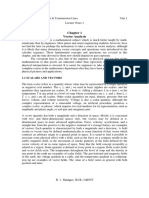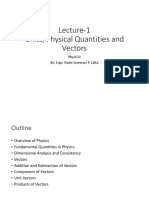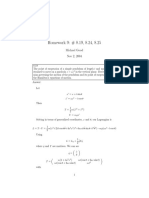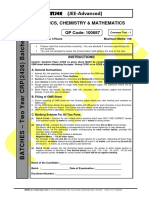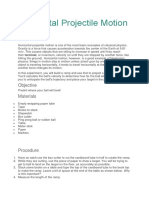Module 2 - Vector and Scalar
Uploaded by
Hanah ArzModule 2 - Vector and Scalar
Uploaded by
Hanah ArzVECTOR and SCALAR
Physics for Engineers
Second Semester, S.Y. 2020-2021
MODULE II
Course Code : Phys 123/121L
Course Title : Physics for Engineers (Lec/Lab)
Pre-requisite : Math 113, Math 123
Co-requisite : Math 113; Phys 121L
Credits Units : 4 units
Time Allotment : 6 hrs./week; 108 hours/semester
For this module : 1 week only
JUNDHEL D. CABRADILLA, REE
Instructor
1|Page Engr. Jundhel Cabradilla | SOE family - BiPSU
➢
This module covers basic concepts, principles, and history of physics. Course topic will
include topics in Vectors; kinematics; dynamics; work, energy, and power; impulse and
momentum; rotation; dynamics of rotation; elasticity; and oscillation. Fluids; thermal
expansion, thermal stress; heat transfer; calorimetry; waves; electrostatics; electricity;
magnetism; optics; image formation by plane and curved mirrors; and image formation by
thin lenses.
The students had to engage as an independent learner in this self-study designed
module. Also, the students had to familiarize themselves with the topics through the series
of explanations and examples given.
After this learning packet, the students will be able to:
- Distinguish between scalars and vectors.
- Recognize quantities as either scalars or vectors.
- Find the resultant of perpendicular vectors.
- Describe how to find the resultant of two vectors.
- Resolve co-planar vectors.
- Solve problems about vector addition and resolution.
Students must submit their Answers to Pre-Test before the module release & submit their
answers to Post Assessment Test & of Culminating Activity on the date indicated at the
Google Classroom.
2|Page Engr. Jundhel Cabradilla | SOE family - BiPSU
➢
Acceleration – is a vector quantity that is defined as the rate at which an object changes
its velocity.
Dynamics – the study of the causes of motion and changes in motion.
Elasticity - is the ability of a body to resist a distorting influence and to return to its original
size and shape when that influence or force is removed.
Electricity - a form of energy resulting from the existence of charged particles (such as
electrons or protons), either statically as an accumulation of charge or dynamically as a
current.
Energy - is the capacity to do work.
Fluids - is a substance that continually deforms (flows) under an applied shear stress, or
external force.
Force - is a push or pull upon an object resulting from the object's interaction with another
object.
Impulse - is a quantity that describes the effect of a net force acting on an object (a kind
of "moving force").
Inertia - is the resistance of any physical object to any change in its velocity.
Kinematics – branch of classical mechanics that describes the motion of points, bodies
(objects) and systems of bodies (groups of objects) without consideration of the causes
of motion.
Magnetism – the study of physical phenomena that are mediated by magnetic field.
Momentum - is a quantity that describes an object's resistance to stopping (a kind of
"moving inertia").
Optics – the branch of physics which involves the behavior and properties of light,
including its interactions with matter and the construction of instruments that use or detect
it.
Oscillation - is defined as the process of repeating variations of any quantity or measure
about its equilibrium value in time.
Power - is the rate, per unit time, at which electrical energy is transferred by an electric
circuit.
Resistance - is a measure of the opposition to current flow in an electrical circuit.
Rotation - is a circular movement of an object around a center (or point) of rotation.
Scalar - is a quantity that can be completely described by a number (called its magnitude)
and a unit.
Vector - is a quantity that requires both magnitude (size) and direction to be completely
described.
Voltage - is the potential difference in charge between two points in an electrical field.
Wave - is a disturbance in a medium that carries energy without a net movement of
particles.
Work - measure of energy transfer that occurs when an object is moved over a distance
by an external force at least part of which is applied in the direction of the displacement.
3|Page Engr. Jundhel Cabradilla | SOE family - BiPSU
Every physical quantity can be classified as either a scalar or a vector quantity.
Scalar is a quantity that can be completely described by a number (called its
magnitude) and a unit. Examples of scalars are length, temperature, and volume. All
these quantities can be expressed by a number with the appropriate units. For
example, the length of a steel beam is expressed as 18 ft; the temperature at 11:00
A.M. is 15°C; the volume of a room is 300 m3.
Vector is a quantity that requires both magnitude (size) and direction to be
completely described. Examples of vectors are force, displacement, and velocity. To
completely describe a force, you must give not only its magnitude (size or amount),
but also its direction.
To describe the change of position of an object, such as an airplane flying from one
city to another, we use the term displacement. Displacement is the net change in
position of an object, or the direct distance and direction it moves. For example, to
completely describe the flight of a plane between two cities requires both the distance
between them and the direction from the first city to the second (Fig. 3.1). The units
of displacement are length units, such as metres, kilometers, feet, or miles.
4|Page Engr. Jundhel Cabradilla | SOE family - BiPSU
To represent a vector in a diagram, we draw an arrow that points in the correct
direction. The magnitude of the vector is indicated by the length of the arrow. We
usually choose a scale, such as 1.0 cm 25 mi, for this purpose (Fig. 3.4).
Thus, a displacement of 100mi west is drawn as an arrow (pointing west) 4.0 cm
long [Fig. 3.4(a)] since
100 mi x 1cm/25mi=4cm
Displacements of 50mi north [Fig. 3.4(b)] and east [Fig. 3.4(c)] using the same scale
are also shown.
Example 1:
5|Page Engr. Jundhel Cabradilla | SOE family - BiPSU
Example 2:
6|Page Engr. Jundhel Cabradilla | SOE family - BiPSU
Components of Vectors
Before we study vectors further, we need to discuss components of vectors and the
number plane:
Number plane - (sometimes called the Cartesian coordinate system, after René
Descartes) consists of a horizontal line called the x-axis and a vertical line called the
y-axis intersecting at a right angle at a point called the origin as shown in Fig. 3.9.
These two lines divide the number plane into four quadrants, which we label as
quadrants I, II, III, and IV. The x-axis contains positive numbers to the right of the
origin and negative numbers to the left of the origin. The y-axis contains positive
numbers above the origin and negative numbers below the origin.
Graphically, a vector is represented by a directed line segment. The length of the line
segment indicates the magnitude of the quantity. An arrowhead indicates the
direction. If A and B are the end points of a line segment as in Fig. 3.10, the symbol
AB denotes the vector from A to B. Point A is called the initial point. Point B is called
the terminal point or end point of the vector. Vector BA has the same length as vector
AB but has the opposite direction. Vectors may also be denoted by a single letter,
such as u, v, or R. The sum of two or more vectors is called the resultant vector.
When two or more vectors are added, each of these vectors is called a component
of the resultant vector. The components of vector R in Fig. 3.11(a) are vectors A, B,
and C. Note: A vector may have more than one set of component vectors. The
components of vector R in Fig. 3.11(b) are vectors E and F.
7|Page Engr. Jundhel Cabradilla | SOE family - BiPSU
Negative of a Vector
The negative of the vector ⃗⃗⃗
𝐴 is defined as the vector that gives zero when added to
𝐴 . This means that 𝐴 and −𝐴 have the same magnitude but opposite directions.
Vectors are pairs of a direction and a magnitude. We usually represent a vector with
an arrow:
The direction of the arrow is the direction of the vector, the length is the magnitude.
We are often interested in the components of a vector that are perpendicular to each
other and that are on or parallel to the x- and y-axes. In particular, we are interested
in the type of component vectors shown in Fig. 3.11(b) (component vectors E and
F). The horizontal component vector that lies on or is parallel to the x-axis is called
the x-component. The vertical component vector that lies on or is parallel to the y
axis is called the y-component. Three examples are shown in Fig. 3.12.
The x- and y-components of vectors can also be expressed as signed numbers. The
absolute value of the signed number corresponds to the magnitude (length) of the
component vector. The sign of the number corresponds to the direction of the
component as follows:
8|Page Engr. Jundhel Cabradilla | SOE family - BiPSU
Example 1:
Find the x- and y-components of vector R in Fig. 3.13.
Rx = x-component of R = + 4
Ry = y-component of R = + 3
Example 2:
Find the x- and y-components of vector R in Fig. 3.14.
Rx = x-component of R = + 6
Ry = y-component of R = - 8
(The y-component points in a negative direction.)
Example 3:
Find the x- and y-components of vector R in Fig. 3.14.
Rx = - 12
Ry = - 9
(Both x- and y-components point in a
negative direction.)
9|Page Engr. Jundhel Cabradilla | SOE family - BiPSU
A vector is in standard position when its initial point is at the origin of the number
plane. A vector in standard position is expressed in terms of its magnitude (length)
and its angle θ, where θ is measured counterclockwise from the positive x-axis to the
vector. The vectors shown in Fig. 3.17 are in standard position.
Finding the Components of a Vector
In general, find the x- and y-components of a vector as follows. First, draw any vector
A in standard position; then, draw its x- and y-components as shown in Fig. 3.20.
Use the right triangle to find the x-component as follows:
10 | P a g e Engr. Jundhel Cabradilla | SOE family - BiPSU
To find the x- and y-components of a vector A given in standard position:
1. Complete the right triangle with the legs being the x- and y-components of the
vector.
2. Find the lengths of the legs of the right triangle as follows:
|𝐴𝑥 | = |𝐴|(cos 𝛼)
|𝐴𝑦 | = |𝐴|(sin 𝛼)
where angle α is the acute angle between vector A in standard position and the
x-axis.
3. Determine the signs of the x- and y-components
11 | P a g e Engr. Jundhel Cabradilla | SOE family - BiPSU
Example 1:
Find the x- and y-components of the vector A 10.0 m at 60.0°.
First, draw the vector in standard position. Then, draw a right triangle where the legs
represent the x- and y-components. The absolute value of the x-component of the vector is
the length of the side adjacent to the 60.0° angle. Therefore, to find the x-component
side adjacent to 60.0° |Ax |
cos 60.0° = =
hypotenuse 10.0 m
|𝐴𝑥 |
cos 60.0° =
10.0 𝑚
|𝑨𝒙 | = 𝟓. 𝟎 𝒎 ans.
Since the x-component is pointing in the positive x-direction, 𝑨𝒙 = +5.00 m
side opposite to 60.0° |Ay |
sin 60.0° = =
hypotenuse 10.0 m
|𝐴𝑦 |
sin 60.0° =
10.0 𝑚
|𝑨𝒚 | = 𝟖. 𝟔𝟔 𝒎 ans.
Since the y-component is pointing in the positive y-direction, 𝐴𝑦 = +8.66 m.
12 | P a g e Engr. Jundhel Cabradilla | SOE family - BiPSU
Example 2:
Find the x- and y-components of the vector B 13.0 km at 220.0°.
First, draw the vector in standard position. Then, complete a right triangle with the x- and
y-components being the two legs. We will let angle (Greek letter alpha) be the acute angle
(an angle whose measure is less than 90°) between the vector in standard position and the
x-axis. Find angle as follows:
80°+ α = 220.0°
α = 40.0°
side opposite to α
sin 60.0° =
hypotenuse
|𝐵𝑦 |
sin 40.0° =
13.0 km
|By | = 8.36 km ans.
Since the y-component is pointing in the negative y-direction, 𝐁𝐲 = - 8.36 km.
13 | P a g e Engr. Jundhel Cabradilla | SOE family - BiPSU
Example 3:
Find the x- and y-components of the vector C 27.0 ft at 125.0°
First, draw the vector in standard position. Then, complete a right triangle with the x- and
y-components being the two legs. Find angle as follows:
α + 125.0°= 180.0°
α = 55.0°
Next, find the x-component as follows:
|Cx | = |C|(cos α)
|Cx | = (27.0 ft)(cos 55.0°)
= 15.5 ft
Since the x-component is pointing in the negative x-direction,
𝐂𝐱 = −15.5 ft
Then, find the y-component as follows:
|Cy | = |C|(sin α)
|Cy | = (27.0 ft)(sin 55.0°)
= 22.1 ft
Since the y-component is pointing in the positive y-direction
𝐂𝐲 = +22.1 ft
14 | P a g e Engr. Jundhel Cabradilla | SOE family - BiPSU
Two vectors ⃗𝑨⃗ and ⃗𝑩⃗ can be added geometrically with the triangle method. The
two vectors are drawn to scale on graph paper, with the tail of the second vector
located at the tip of the first. The resultant vector is the vector drawn from the tail
of the first vector to the tip of the second. The negative of a vector ⃗𝑨 is a vector
with the same magnitude as ⃗𝑨 ⃗ , but pointing in the opposite direction. A vector can
be multiplied by a scalar, changing its magnitude, and its direction if the scalar is
negative.
Addition of Vectors
When two or more vectors are added, they must all have the same units. For
example, it doesn’t make sense to add a velocity vector, carrying units of meters per
second, to a displacement vector, carrying units of meters. Scalars obey the same
rule: It would similarly meaningless to add temperatures to volumes or masses to
time intervals.
⃗⃗⃗
𝑹 = ⃗⃗⃗
𝑨 + ⃗𝑩⃗ : triangle method of addition
⃗⃗⃗
𝑨 + ⃗𝑩
⃗ = 𝑩⃗⃗ + 𝑨
⃗⃗⃗ : commutative law of addition
To solve a vector addition problem graphically such as displacement:
1. Choose a suitable scale and calculate the length of each vector.
2. Draw the north–south reference line. Graph paper should be used.
3. Using a ruler and protractor, draw the first vector and then draw the
other vectors so that the initial end of each vector is placed at the
terminal end of the previous vector.
4. Draw the resultant vector from the initial end of the first vector to the
terminal end of the last vector.
5. Measure the length of the resultant and use the scale to find the
magnitude of the vector. Use a protractor to measure the angle of the
resultant.
15 | P a g e Engr. Jundhel Cabradilla | SOE family - BiPSU
Example 1:
16 | P a g e Engr. Jundhel Cabradilla | SOE family - BiPSU
Example 2:
17 | P a g e Engr. Jundhel Cabradilla | SOE family - BiPSU
Example:
18 | P a g e Engr. Jundhel Cabradilla | SOE family - BiPSU
Finding a Vector from Its Components
Example 1:
19 | P a g e Engr. Jundhel Cabradilla | SOE family - BiPSU
Example 2:
20 | P a g e Engr. Jundhel Cabradilla | SOE family - BiPSU
Glossary:
Component Vector - When two or more vectors are added, each of the vectors is called a
component of the resultant, or sum, vector.
Displacement - The net change in position of an object, or the direct distance and direction
it moves; a vector.
Number Plane - A plane determined by the horizontal line called the x-axis and a vertical
line called the y-axis intersecting at a right angle at a point called the origin.
These two lines divide the number plane into four quadrants. The x-axis contains
positive numbers to the right of the origin and negative numbers to the left of the origin.
The y-axis contains positive numbers above the origin and negative numbers below
the origin.
Resultant Vector - The sum of two or more vectors.
Scalar - A physical quantity that can be completely described by a number (called its
magnitude) and a unit.
Standard Position - A vector is in standard position when its initial point is at the origin of
the number plane. The vector is expressed in terms of its length and its angle, where is
measured counterclockwise from the positive x-axis to the vector.
Vector - A physical quantity that requires both magnitude (size) and direction to be
completely described.
x-component - The horizontal component of a vector that lies along the x-axis.
y-component - The vertical component of a vector that lies along the y-axis.
Formulas:
21 | P a g e Engr. Jundhel Cabradilla | SOE family - BiPSU
❖Suggested Readings
➢ Applied Physics - 10th Edition by Ewen, D., Schurter, N., & Gundersen, P.
E. (2012)
➢ College Physics – 9th Edition by Raymond A. Serway and Chris Vuille
For inquiries, you may call or text and chat:
ENGR. JUNDHEL D. CABRADILLA
Contact: 09751070490
Email address: engr.juncab@gmail.com
Facebook account: Engr. JC
22 | P a g e Engr. Jundhel Cabradilla | SOE family - BiPSU
23 | P a g e Engr. Jundhel Cabradilla | SOE family - BiPSU
You might also like
- Lesson 1 - Introduction To Physics and MeasurementNo ratings yetLesson 1 - Introduction To Physics and Measurement12 pages
- (AR) 1968 - Numerical Solution of The Navier-Stokes Equations - Chorin PDFNo ratings yet(AR) 1968 - Numerical Solution of The Navier-Stokes Equations - Chorin PDF18 pages
- Solutions For Classical Mechanics - Goldstein.H (2 Edition)0% (1)Solutions For Classical Mechanics - Goldstein.H (2 Edition)10 pages
- Chapter 2 Scalar and Vector Quantities-2024 NotesNo ratings yetChapter 2 Scalar and Vector Quantities-2024 Notes18 pages
- Chapter 2 Vectors and Scalars -2024 Notes 250120 194132No ratings yetChapter 2 Vectors and Scalars -2024 Notes 250120 19413218 pages
- Vectors and Scalars, Addition of Vectors Q2 Module 2100% (1)Vectors and Scalars, Addition of Vectors Q2 Module 211 pages
- AP1201 - CH - 1 - PPT - 01 - VectorsV2013No ratings yetAP1201 - CH - 1 - PPT - 01 - VectorsV201316 pages
- Yabello Ifa Boru Special Boarding Secondary School Physics Short Note For Grade 11 BY: Wondimu Getachew (2016 EC)No ratings yetYabello Ifa Boru Special Boarding Secondary School Physics Short Note For Grade 11 BY: Wondimu Getachew (2016 EC)91 pages
- Vector Analysis From Scratch (Math Beyond Numbers) (David Smith)No ratings yetVector Analysis From Scratch (Math Beyond Numbers) (David Smith)198 pages
- Vector Analysis: 1.1 Scalars and VectorsNo ratings yetVector Analysis: 1.1 Scalars and Vectors9 pages
- Vector Analysis: 1.1 Scalars and VectorsNo ratings yetVector Analysis: 1.1 Scalars and Vectors9 pages
- Vector Analysis: 1.1 Scalars and VectorsNo ratings yetVector Analysis: 1.1 Scalars and Vectors9 pages
- Scalars and Vectors Fundamentals of Physics Halliday, Resnick & WalkerNo ratings yetScalars and Vectors Fundamentals of Physics Halliday, Resnick & Walker16 pages
- Pssutc: Theme: The Scalar Product of Two Vectors. Work Done by A Varying ForceNo ratings yetPssutc: Theme: The Scalar Product of Two Vectors. Work Done by A Varying Force15 pages
- Lecture - 1 - DR Nader Shehata - Review On Vectors and ScalarsNo ratings yetLecture - 1 - DR Nader Shehata - Review On Vectors and Scalars41 pages
- Kristian James P. Seledio: Quick Check 1No ratings yetKristian James P. Seledio: Quick Check 14 pages
- 10+1 Physics Book-3 Vectors & Motion in A PlaneNo ratings yet10+1 Physics Book-3 Vectors & Motion in A Plane112 pages
- Technical Sciences Grade 10 Term 1 Week 4_2021No ratings yetTechnical Sciences Grade 10 Term 1 Week 4_20214 pages
- General Physics 1: Learning Activity SheetNo ratings yetGeneral Physics 1: Learning Activity Sheet32 pages
- Module 5 - IMPULSE, MOMENTUM and COLLISION100% (1)Module 5 - IMPULSE, MOMENTUM and COLLISION21 pages
- Module 8 - Temperature, Heat Quantities and Heat TransferNo ratings yetModule 8 - Temperature, Heat Quantities and Heat Transfer22 pages
- Common Test 1 - Two Year CRP (426) Batches - 3 6 24No ratings yetCommon Test 1 - Two Year CRP (426) Batches - 3 6 2412 pages
- Lab 06: The Speed of Sound in Air: NtroductionNo ratings yetLab 06: The Speed of Sound in Air: Ntroduction2 pages
- Finite Element Analysis of Saturated Sand Layer Under Earhtquake LoadingNo ratings yetFinite Element Analysis of Saturated Sand Layer Under Earhtquake Loading14 pages
- Roughness Body Reynolds-Number: The Effect of Surface of The High FlowNo ratings yetRoughness Body Reynolds-Number: The Effect of Surface of The High Flow11 pages
- Comparative Design of Biaxial RC ColumnsNo ratings yetComparative Design of Biaxial RC Columns14 pages
- Calculo de Licuacion-Estribo Derecho Puente PardoNo ratings yetCalculo de Licuacion-Estribo Derecho Puente Pardo6 pages
- Diederichs Et Al. 2004 Damage Initiation and Propagation in Hard Rock During TunnelingNo ratings yetDiederichs Et Al. 2004 Damage Initiation and Propagation in Hard Rock During Tunneling28 pages
- Lesson 1 - Introduction To Physics and MeasurementLesson 1 - Introduction To Physics and Measurement
- (AR) 1968 - Numerical Solution of The Navier-Stokes Equations - Chorin PDF(AR) 1968 - Numerical Solution of The Navier-Stokes Equations - Chorin PDF
- Solutions For Classical Mechanics - Goldstein.H (2 Edition)Solutions For Classical Mechanics - Goldstein.H (2 Edition)
- Chapter 2 Vectors and Scalars -2024 Notes 250120 194132Chapter 2 Vectors and Scalars -2024 Notes 250120 194132
- Vectors and Scalars, Addition of Vectors Q2 Module 2Vectors and Scalars, Addition of Vectors Q2 Module 2
- Yabello Ifa Boru Special Boarding Secondary School Physics Short Note For Grade 11 BY: Wondimu Getachew (2016 EC)Yabello Ifa Boru Special Boarding Secondary School Physics Short Note For Grade 11 BY: Wondimu Getachew (2016 EC)
- Vector Analysis From Scratch (Math Beyond Numbers) (David Smith)Vector Analysis From Scratch (Math Beyond Numbers) (David Smith)
- Scalars and Vectors Fundamentals of Physics Halliday, Resnick & WalkerScalars and Vectors Fundamentals of Physics Halliday, Resnick & Walker
- Pssutc: Theme: The Scalar Product of Two Vectors. Work Done by A Varying ForcePssutc: Theme: The Scalar Product of Two Vectors. Work Done by A Varying Force
- Lecture - 1 - DR Nader Shehata - Review On Vectors and ScalarsLecture - 1 - DR Nader Shehata - Review On Vectors and Scalars
- Master the Fundamentals of Electromagnetism and EM-InductionFrom EverandMaster the Fundamentals of Electromagnetism and EM-Induction
- Biomechanics in Orthodontics: Principles and PracticeFrom EverandBiomechanics in Orthodontics: Principles and Practice
- Vector and Tensor Analysis with ApplicationsFrom EverandVector and Tensor Analysis with Applications
- Module 8 - Temperature, Heat Quantities and Heat TransferModule 8 - Temperature, Heat Quantities and Heat Transfer
- Common Test 1 - Two Year CRP (426) Batches - 3 6 24Common Test 1 - Two Year CRP (426) Batches - 3 6 24
- Finite Element Analysis of Saturated Sand Layer Under Earhtquake LoadingFinite Element Analysis of Saturated Sand Layer Under Earhtquake Loading
- Roughness Body Reynolds-Number: The Effect of Surface of The High FlowRoughness Body Reynolds-Number: The Effect of Surface of The High Flow
- Diederichs Et Al. 2004 Damage Initiation and Propagation in Hard Rock During TunnelingDiederichs Et Al. 2004 Damage Initiation and Propagation in Hard Rock During Tunneling
















